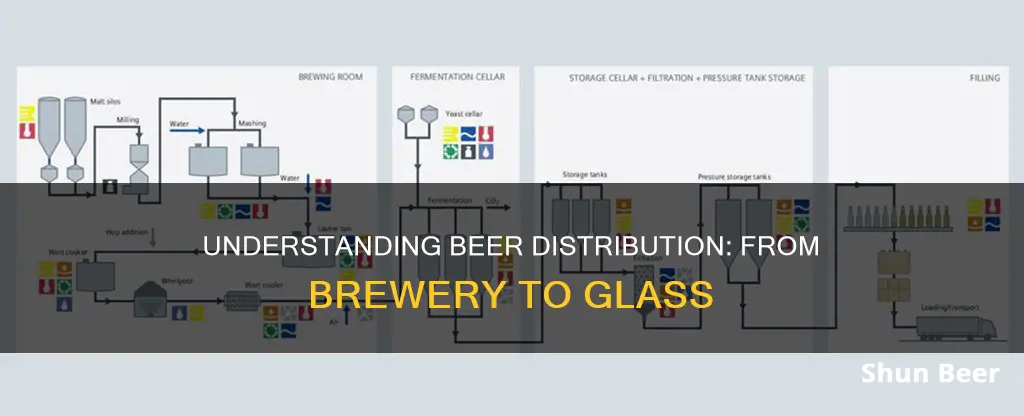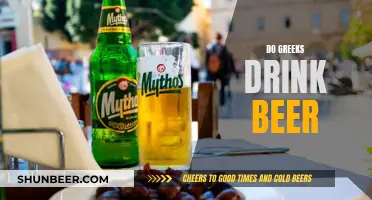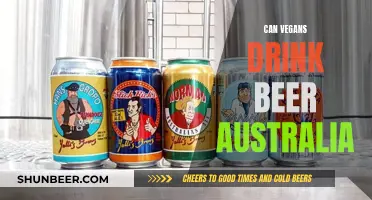
Beer distribution is a complex process that involves multiple stakeholders and a strict regulatory framework. In the United States, a three-tier system is commonly used, where beer is sold through three steps: from the brewer to the distributor, and then to the retailer, who sells it to the customer. Distributors, also known as wholesalers, are independent entities that play a critical role in getting beer from the brewery to the retailer, ensuring a diverse range of options for consumers. They are responsible for the safe and transparent distribution of beer, following federal and state regulations, and often have a significant impact on local communities and economies. Distributors buy beer from brewers, set the price, and sell it to retailers, who then sell it to customers. This system was established to prevent breweries from having too much control over the market and to facilitate the collection of taxes by the government. While it offers benefits such as equal distribution and local market understanding, it also has limitations, including reduced profit margins for breweries and potential issues with product freshness.
What You'll Learn

The three-tier system
- The producer tier: This includes brewers, winemakers, distillers, and importers who package and brew alcoholic beverages.
- The distributor or wholesaler tier: These are independent businesses that range from small, local operations to large multi-state enterprises. Distributors buy products from producers and sell them to retailers.
- The retailer tier: This includes bars, restaurants, liquor stores, supermarkets, and other businesses that sell alcoholic beverages to consumers.
While the three-tier system adds complexity and cost to the distribution process, it has been credited for the boom in American craft beer by encouraging competition and empowering independent distributors. However, it has also faced criticism for adding middlemen, increasing prices, and reducing the freshness of beer.
The system has evolved over time, with some states allowing exceptions and exemptions. For example, some states permit small breweries to act as their own distributors, and brewpubs are allowed to be both producers and retailers. Ultimately, each state has its own rules and variations regarding the three-tier system.
Beer Diet: Does It Work or Is It a Myth?
You may want to see also

Distributors as middlemen
In the US, beer distribution follows a three-tier system, where a middleman or distributor (also called a wholesaler) buys beer from the brewer and sells it to the retailer. This system was introduced after Prohibition to reduce the power of breweries to control the market and prevent monopolization. Distributors are licensed by federal and state governments and are responsible for getting beer to stores, local restaurants, and bars through a safe, transparent, and accountable system. They also help new brands enter the market and ensure a wide selection of beer for consumers.
There are about 3,000 independent beer distribution facilities in the US, providing jobs and contributing to the economy. Distributors are also small business owners and community leaders, playing a vital role in promoting responsible consumption and reducing drunk driving and underage drinking.
The relationship between breweries and distributors is critical. Distributors need good beer to offer retailers, and breweries rely on distributors to get their products to market quickly and efficiently. This relationship is usually permanent, and it is challenging for breweries to switch distributors. Distributors sell competing brands, and while they are responsible for promoting the beer, they often only focus on their top-selling brands.
Distributors have extensive market knowledge and connections, allowing breweries to focus on their business strategies and product development. They can also help breweries expand into new markets. However, using a distributor reduces a brewery's control over its product and cuts into its margins, as distributors take a percentage of the profits. Distributors determine how and where the beer is sold, and smaller breweries may struggle to get noticed among the many brands that distributors carry.
Some breweries, especially smaller ones, may choose self-distribution to maintain control and improve margins. However, self-distribution requires a high upfront capital investment and is illegal in some states.
Tums to the Rescue: Beer Sickness Solution?
You may want to see also

Self-distribution
However, there are also limitations to self-distribution. Firstly, it requires a high capital investment upfront. To self-distribute, breweries need to hire salespeople, purchase vehicles and fuel for transportation, and acquire equipment such as forklifts and pallet jacks. These costs can add up to hundreds of thousands of dollars. Secondly, self-distribution may be illegal in certain states. Therefore, breweries need to be aware of the local regulations and ensure they are compliant. Lastly, self-distribution can be time-consuming and resource-intensive, requiring a significant focus from management.
Some small brewers choose to initiate self-distribution for the first few years to gain good product representation and placement and then transition to a beer wholesaler to further penetrate the marketplace. Ultimately, the decision to self-distribute or use a distributor depends on the brewery's size, sales strategy, and local regulations.
The Magic Behind Beer Engines: How Do They Work?
You may want to see also

Selecting a distributor
Understanding the Distribution Landscape
Firstly, it's important to understand the distribution landscape. In the US, a three-tier system is in place, where beer is sold through three steps: from the brewer to the distributor (wholesaler) to the retailer. Each state has its own rules, with some allowing breweries to self-distribute, while others permit breweries to own distributors. Distributors are independent and buy the beer from brewers, becoming the sole agents responsible for selling and setting the price of the beer to retailers.
Distributor Types
When selecting a distributor, you'll typically find two to three major brand houses in any given market, representing large brands like Anheuser-Busch, Miller, and Coors. These distributors have a high level of service, extensive contacts, and are very competitive. However, small craft brewers might find themselves overshadowed by the bigger brands these distributors carry.
There may also be miscellaneous brand houses that carry a variety of products beyond the major brands, including regional breweries, popular imports, and non-alcoholic beverages. They offer a good alternative for small brewers as they usually provide a high level of service.
Additionally, some markets have small specialty distributors that focus on handcrafted, authentic beers, often including imports and domestic craft beers. These distributors are passionate about beer and offer knowledgeable sales staff. However, they may have limited resources and tend to service only the most important accounts.
Liquor/wine distributors can also be an option for small brewers, as they typically cover broader territories and have strong product knowledge. However, their focus may be more on high-margin wine and spirits, and their call frequency to retail accounts may be lower than beer-focused distributors.
Distributor Selection Criteria
When evaluating distributors, consider the following criteria:
- Longevity: Choose a distributor that suits your current needs and will continue to be a good fit in the long term.
- Market Presence: Spend time in the marketplace to understand the dynamics and gather insights from retailers about their preferred distributors.
- Craft Beer Expertise: Assess the distributor's knowledge and success in selling craft beers.
- Brand Management: Inquire about brand managers or specific personnel responsible for your product line.
- Refrigeration and Draft Support: Ensure the distributor has adequate refrigeration space and provides reliable draft support and service.
- Financial Stability: Evaluate the distributor's financial strength and understand the margins they typically work with.
- Comfort and Trust: Select a distributor with whom you feel comfortable and can build a lasting, mutually beneficial relationship.
- Contract Terms: Consult a lawyer to review the contract terms, including pricing, expansion, marketing, reliability, and payment.
Self-Distribution
Self-distribution is another option, especially for small brewers looking to gain initial product representation and placement. However, it is limited by geographic scope and requires significant time, resources, and management focus.
The Science Behind Beer Koozies: Do They Really Work?
You may want to see also

Distributors' role in communities
Distributors play a vital role in communities, and their responsibilities go beyond just buying, storing, selling, and delivering beer. Distributors are often small business owners, civic leaders, parents, and philanthropists who are actively involved in their communities. They play a crucial role in promoting responsible consumption, combating drunk driving, and reducing underage drinking. They also value their role in the state-based system of alcohol regulation, which helps keep communities safe while encouraging a robust marketplace.
In the United States, the three-tier distribution system, established after Prohibition ended in 1933, includes producers (breweries), distributors, and buyers (bars or retailers). Distributors are independent, licensed entities that act as the middlemen, transporting beer from breweries to bars or retailers. They are responsible for ensuring the quality and safety of the beer and play a crucial role in tax collection. Distributors also provide infrastructure and refrigerated storage to maintain the freshness of the product.
The role of distributors as hybrid sales and logistics companies is crucial. They invest in building relationships with suppliers, retailers, and consumers, which is essential for their success. Distributors provide a clear path for sales and service to retail accounts, and their relationships with store owners can lead to better product placement and promotions. Distributors also handle the warehousing and delivery of beer, ensuring that it reaches even the most rural markets.
In addition to their economic contributions, beer distributors are also committed to social responsibility. They sponsor various programs that promote responsible consumption and work to prevent drunk driving and underage drinking. Distributors understand the importance of keeping their communities safe while also fostering a vibrant and competitive marketplace.
Underground Beer Coolers: Do They Keep Drinks Chilled?
You may want to see also
Frequently asked questions
Beer distributors are the middlemen between brewers and retailers. Distributors buy beer from brewers and sell it to retailers, who then sell it to customers. Distributors are responsible for delivering beer to retailers and storing it.
Distributors are independent and ensure that all brewers, regardless of size, have equal access to distribution and retailers. Distributors also help promote responsible consumption and work to reduce drunk driving and underage drinking.
The three-tier system for beer distribution was introduced after Prohibition to prevent alcohol producers from directly selling to the public and taking advantage of the system. The system includes brewers, distributors, and retailers.
Yes, breweries can sell directly to customers, bypassing the three-tier system. This is known as self-distribution. However, self-distribution is not allowed in all states and is more feasible for local sales.
Breweries should consider factors such as market knowledge, connections, and compatibility with their long-term goals when selecting a distributor. It is also important to understand the terms of the contract, including margins and responsibilities.







